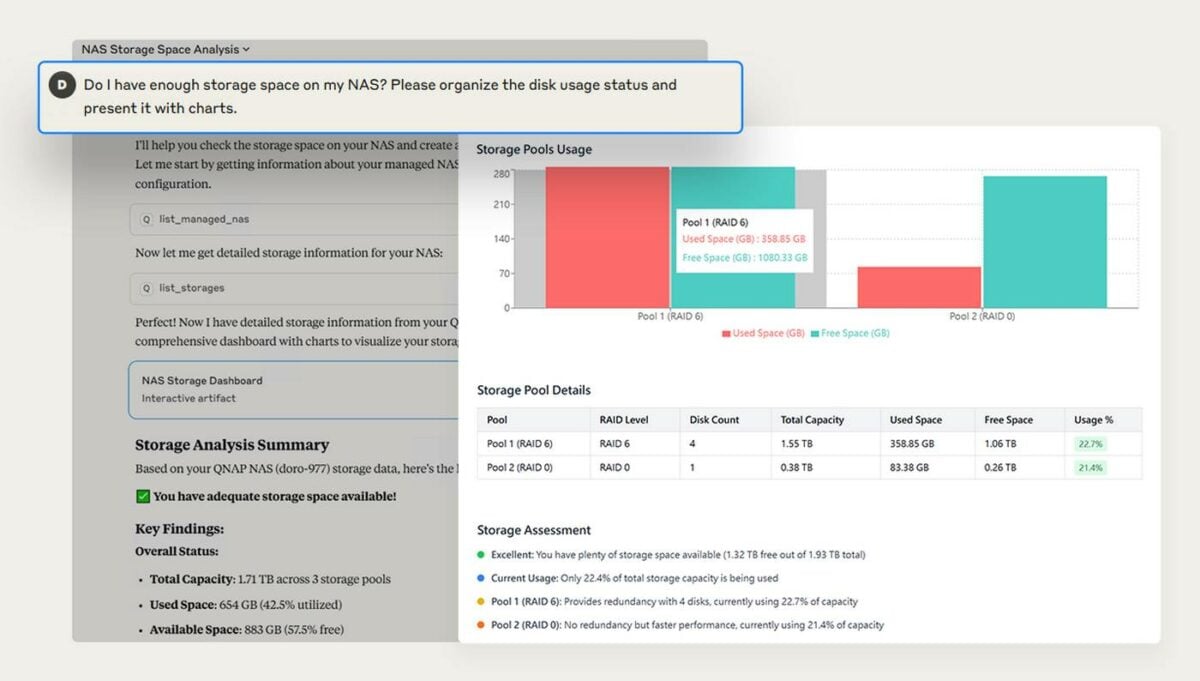QNAP, maker of NAS and networking devices, has announced support for the Model Context Protocol (MCP) across its NAS systems. Currently in beta, the MCP Assistant leverages AI to understand and execute users’ commands issued in plain and natural language. The aim is to help you navigate and manage your NAS systems without having to deal with complex interfaces and technical syntax.
Don’t have time to dig through thousands of system logs to find an issue? Need to edit user permissions or change some obscure setting? Or simply wondering if your NAS has space for your new vacation videos? MCP is here to help, QNAP says. All you need to do is ask like you would with a friend, and the Assistant should comply. QNAP believes the MCP Assistant is capable of solving all of these and more, saving you time and tuning your NAS to your liking.
What is MCP?
The Model Context Protocol (MCP) is an open standard that links AI models to external systems, enabling them to understand contexts, access tools or data, and execute real tasks through an MCP Host. It can interact directly with systems, perform operations, and return actionable results.
Why is MCP support a game-changer for QNAP NAS?
Traditionally, NAS management required navigating web interfaces or using command-line tools, which can be significant barriers for non-technical users. With QNAP MCP Assistant, everyone can express their request naturally and get things done.
“Our goal with MCP Assistant is to make NAS operations accessible to everyone,” said Tim Lin, Product Manager at QNAP. “You don’t need to know the system or memorize commands—just say what you want to do, and the NAS takes care of it. This makes IT management more intelligent and more human-centered.”
How does it work?
- The user issues a request using natural language.
- The MCP Host analyses the request and translates it into instructions.
- The AI identifies the appropriate endpoint for the task.
- The MCP assistant on the NAS receives and begins processing the request.
- The NAS completes and sends the result back to be displayed.
Key Features of QNAP MCP Assistant include:
- Natural Language Control: Interact with your NAS using everyday language – no command-line knowledge required.
- Context-Aware Conversations: Supports multi-turn dialogue and understands follow-up questions and task context.
- Cross-Platform Integration: Works with tools like Claude Desktop, Visual Studio Code, Telegram, and n8n to fit your existing workflows.
- Granular Access Control: Includes token/key-based authentication, read-only mode, and feature-level permissions to ensure safe usage.
- Supported Task Categories: Covers shared folder and user management, system monitoring, storage operations, file handling, and advanced Qsirch-powered semantic search.

The MCP Assistant supports a wide range of NAS management tasks, such as:
Shared Folder Management
- View all shared folders.
- Create new shared folders with custom settings.
- Check and update folder permissions.
User & Group Management
- Create, view, and delete user accounts.
- Manage user groups and members.
- Assign group access to shared folders.
NAS Status Monitoring
- Query system logs.
- Monitor CPU/memory load and system health.
- View installed apps (QPKG).
Storage Management
- Check storage pool and volume info.
- Monitor disk usage status.
File Operations
- Browse, copy, move, or delete files.
- Create folders and manage file structure.
- Search for files across the entire NAS.
Qsirch Advanced Search Integration
- Search using keywords and filters.
- Group results by file type.
- Explore all available search categories.
Most importantly, the MCP Assistant does all of this while maintaining a secure environment using token/key-based authentication, feature-level permission controls, and read-only mode to prevent unauthorised changes.
Interested? To get started, you will need a QNAP NAS running QTS 5.2 or later / QuTS hero h5.2 or later operating systems, plus a Claude Desktop, Copilot, Cline, or Cherry Studio Host machine. A detailed guide can be found here. Before installing, note that some users have indicated that the MCP Assistant is not yet supported in QuTS 5.3, requiring a downgrade to 5.2.


